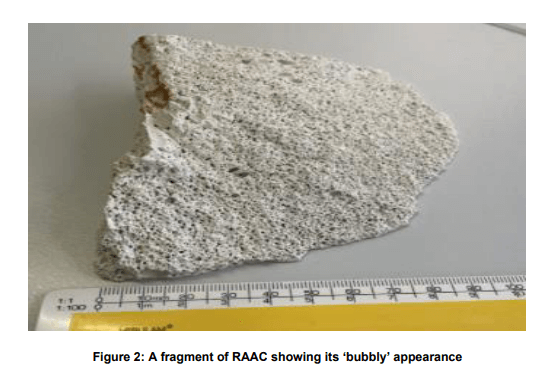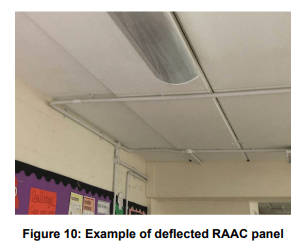RAAC crisis in schools sparks asbestos fears
Last Updated on 19 December 2023
RAAC crisis in schools sparks asbestos fears
You have mostly heard of asbestos and more likely the issue of asbestos in schools. However, there is a hugely important interplay between the two topics because there’s a new monster coming over the hill. Actually, it’s been sat on the hill for a while not moving, but now it has finally been noticed. What is this new monster you ask? RAAC (reinforced autoclaved aerated concrete). In simple terms, RAAC is concrete that’s past its sell-by date with limited structural integrity, and it’s sparking new fears concerning the added risk of asbestos exposure in our schools.
The reason for this is due to the fact that RAAC has a lifespan of 30 years, and as such, is now considered hazardous in schools as it has surpassed its lifespan. As a result, the UK government has recently ordered that all RAAC is assessed and any damaged or deteriorating concrete panels are removed, thus causing concern as this process could potentially disturb asbestos. Asbestos was another common building material that was used in the same time period, so many experts believe that where RAAC is present, you’re often likely to find asbestos-containing materials (ACMs).
But before we delve into the concerns and issues surrounding RAAC, let’s firstly talk about the topic of asbestos in schools. The government’s own figures suggest that over 80% of UK schools contain varying quantities of asbestos. Some of which is in poor condition. This issue is often compounded by lack of , or poor asbestos surveys, and then compounded further by (in some cases) abject asbestos management efforts and a lack of appropriate awareness or management training.

What is Reinforced Autoclaved Aerated Concrete (RAAC)?
Reinforced Autoclaved Aerated Concrete, or RAAC, is made from sand, cement, lime, and aluminium powder. It is a type of precast concrete that is infused with air bubbles during the manufacturing process. These tiny air bubbles give RAAC its lightweight and porous nature, which traditionally made it an excellent alternative to traditional concrete.
In RAAC, traditional reinforcement materials such as steel bars or mesh are incorporated into the aerated concrete panels or blocks to enhance their structural integrity and load-bearing capacity.
RAAC is not a new kid on the block. It dates back to the early 1920s when it was first developed in Sweden.
Once hailed as an innovative, versatile and eco-friendly building material, there are now concerns emerging about the use of RAAC in schools, hospitals and other public buildings. The main concerns are around its long-term durability, structural integrity and safety.

Image courtesy of https://assets.publishing.service.gov.uk/
Why was RAAC used as a building material?
RAAC was a popular building material used from the 1950’s through to the mid 1990’s in the UK. It was mainly used in walls and partitions in residential, commercial, industrial and public buildings such as schools and hospitals. One of the primary advantages of using RAAC was its lightweight composition. Because It weighs significantly less than traditional concrete, it made it easier to transport, handle, and install.
Another advantage of using RAAC was its excellent thermal insulation properties. Its porous structure helps maintain stable indoor temperatures, reducing the need for excessive heating or cooling. Additionally, the air bubbles in RAAC not only provide thermal insulation, but also act as sound barriers.

Image courtesy of https://assets.publishing.service.gov.uk/
So what’s the interplay at work regarding RAAC and asbestos in schools?
Well, the government has rightly ordered ‘duty holders’ (those with responsibility for building safety and maintenance) to find out if they have RAAC, it’s relative condition and assess the risk to building users and occupiers.
How is this achieved? Fundamentally it’s by conducting a survey along with appropriate testing. The survey is usually undertaken by a structural engineer.
Under the Control of Asbestos Regulations 2012 (CAR2012), Specifically regulations 5, 6 & 10, Employers are required to protect their employees from exposure to asbestos and ensure adequate awareness training.
As a result, this requires the employer, in this case the structural engineer, to access appropriate asbestos survey information from the schools or any type of property that may contain RAAC where they are required to work.
Should be straightforward? Well not actually for a number of reasons.
As outlined above, some of the asbestos survey information is inadequate and out of date. Or it doesn’t comply with survey guidance documents.
Asbestos products may be covering or hiding RAAC in schools, which means getting access beyond the asbestos requires the assistance of a licensed asbestos contractor.
Another major issue is that most schools have a management asbestos survey. This type of survey rarely goes beyond the basic visible fabric of the building. In schools, If RAAC concrete is covered by a plasterboard ceiling for example, then a more detailed asbestos survey (refurbishment/demolition)will be required for the structural engineer before they start work.
What is the solution to the RAAC/asbestos crisis?
In order to solve the issue of a potential asbestos crisis in our schools caused by RAAC removal, a sensible approach is required by all parties. We are currently assisting structural engineers by helping them decipher the asbestos survey information in relation to areas they may need to access. This initially could be via desktop work, but for some properties may well require site visits and basic access investigations.
By all parties working together, the school or relevant building duty holders alongside asbestos and structural surveyors, the solution should work.
Without a measured approach in schools, there is a risk individuals can be exposed to asbestos due to the RAAC remediation process. This brings into play RIDDOR regulations and potentially HSE intervention.
Therefore, It’s important duty holders understand their legal duties and act responsibly. The first stage of that process is contacting relevant professionals. We can help with the asbestos element in schools, although we don’t test for RAAC. However, we can point you towards a reputable organisation that does.
If you need help in identifying RAAC in your school, then the government has put together a really useful guide which contains lots of useful information. We would urge you to read this RAAC guidance as a starting point.
Need asbestos advice?
We hope you found our article on RAAC and asbestos in schools both useful and informative. If you need any help or advice at all with any aspect of asbestos then we’ll be very happy to assist you. Give us a call and our experts will give you some advice and guidance on whatever if is you’re concerned about.
Please contact us on 0800 141 2676, email us at info@rbasbestos.co.uk or fill in the form below.
Our professional asbestos surveyors conduct asbestos inspections and asbestos surveys every day across the UK on all types of properties, both residential and commercial, for private home owners and commercial property Managers and owners. So when it comes to managing asbestos in your property, you’re in very safe hands with RB Asbestos Consultants.

